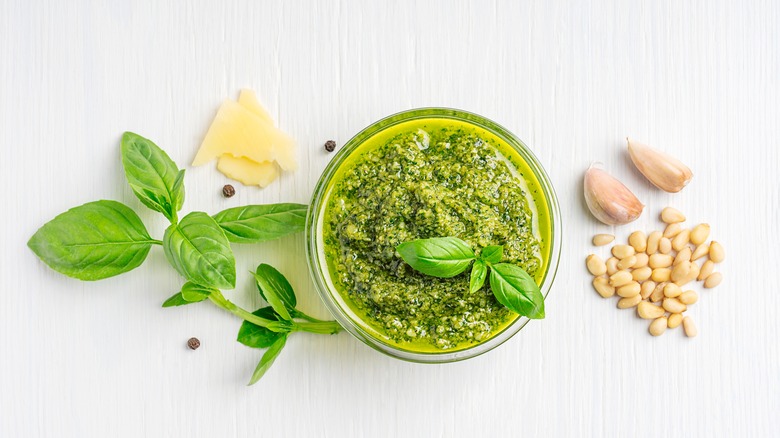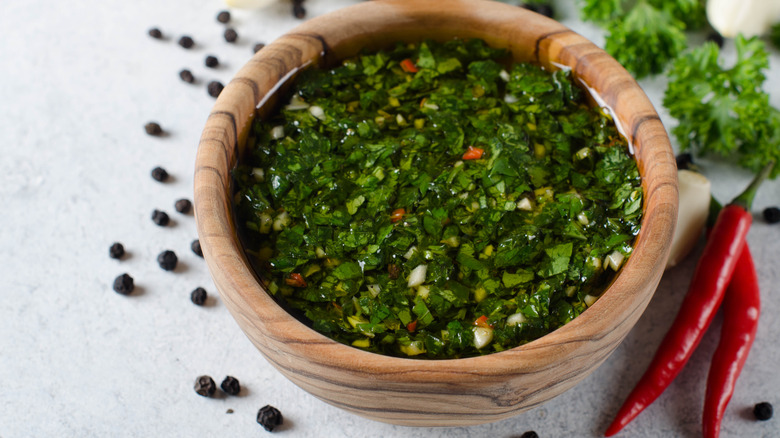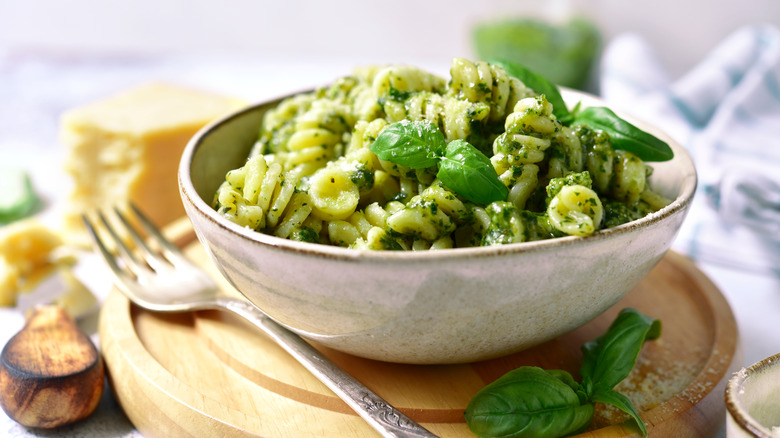Pesto Vs. Chimichurri: The Differences Between The Beloved Green Sauces
The green color in food is always linked to healthy eating and leafy (albeit bitter) greens, but it is also the vibrant color of two flavourful and versatile sauces: pesto and chimichurri. While both seem similar in appearance and ingredients, a deeper look shows its difference in terms of origin, ingredients, and texture.
Pesto is a classic Italian sauce by way of Genoa and is made with fresh basil leaves, garlic, olive oil, pine nuts, and parmesan cheese. It has a deep green color and is traditionally made by grinding the ingredients together in a mortar and pestle for a chunky texture. In fact, pesto is a generic Italian name for any sauce made by pounding ingredients together. These days, people just use a food processor which renders a smoother texture.
Chimichurri, on the other hand, is a sauce that originated in Argentina although it is now widely used in South America. While the core ingredient for pesto is usually basil leaves, in chimichurri it is parsley followed by the usual suspects: garlic, oil (olive or vegetable), vinegar, and red pepper flakes. Some recipes also include other herbs like oregano, cilantro, or thyme. Unlike pesto, chimichurri is not pureed. Instead, the ingredients are chopped finely and mixed together. This results in a liquid sauce with a bright green color.
Pesto has a rich flavor, chimichurri is more tangy
There are many variations for pesto and chimichurri depending on personal preferences and the availability of ingredients. Pesto, as the name suggests, is simply any pounded ingredients so it is not limited to basil leaves. You can also make pesto with kale or arugula and don't let anyone tell you that it is not "authentic" pesto.
As for chimichurri, each household may have its signature method to make it. For example, a BBC report highlights how some people add warm water to help the oil and vinegar emulsify, while others boil the oregano leaves before mixing them with the herb mixture.
Irrespective, pesto and chimichurri have different flavor profiles. Pesto has a rich, nutty flavor from the pine nuts and parmesan cheese. The basil adds a sweetness and the garlic gives it a pungent kick. Chimichurri, on the other hand, has a tangy, herby flavor and the sharpness of the garlic and vinegar contrasts perfectly with the parsley.
Use pesto or chimichurri as a marinade, topping or dip
Given its Italian origin, pesto is usually used as a sauce for pasta or a topping for pizza although it can also be spread on sandwiches or a dip for vegetables or crackers. But there is an art to selecting the right pasta for pesto. Any pasta with a ribbed surface works better than pasta with a smooth surface so that there are grooves for the pesto to cling on. In other words, use penne instead of linguini if you're making pesto pasta.
Chimichurri, on the other hand, is primarily used as a fresh topping for grilled meats. You can spoon it over the top of the meat before so a good test for chimichurri is whether it balances rather than overpowers the taste of smoky meats. This makes it seem like chimichurri is a single-use condiment but it is very versatile and can be used as a marinade, dipping sauce, or condiment. In fact, in Argentina, it is as common as ketchup is in the US.
But pesto or chimichurri does not have to be limited to Italian or South American food respectively. Instead, you can experiment with pesto on vegetable soup or chimichurri on grilled vegetables. Best case, you'll find a new signature dish.


